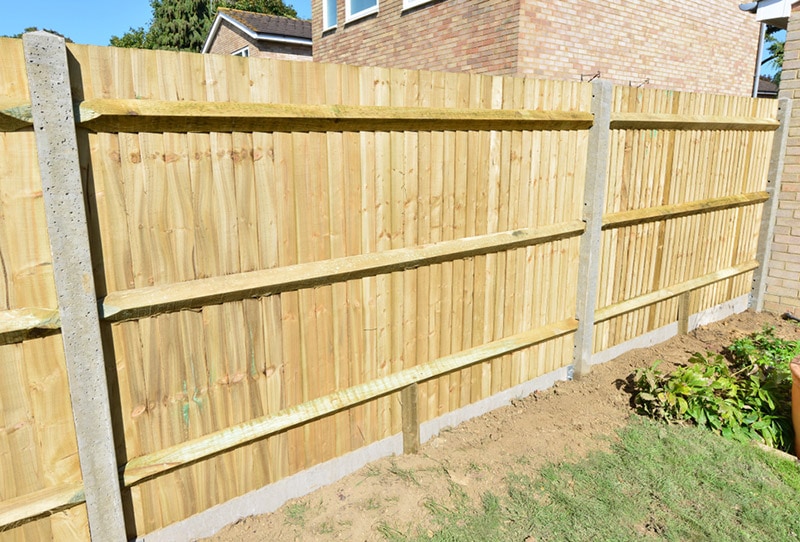How to Keep Dogs Out of Your Yard (12 Effective Ways)
-
Pete Ortiz
- Last updated:

Of the countless critters that grace our yards throughout the year, dogs are one of the most unexpected and least desirable. Even avid dog lovers have enough reasons to keep other people’s pets and strays away. Apart from the immediate threat to your lawn and landscaping, there’s no telling how your pets will respond or if the intruding dog poses a risk to your family.
A problem with recurring visitors will demand a unique solution. Constantly chasing off dogs is a hassle, and it won’t fix the behavior any time soon. Instead, using a deterrent will make life easy for you and send a concrete message to any offenders that your property is off-limits. Give yourself peace of mind with minimal effort by using these tips to keep dogs out of your yard.
The 12 Effective Ways to Keep Dogs Out of Your Yard
1. Talk to Your Neighbor

If you only have issues with one dog coming to your home, the most proactive solution may be to talk to the neighbor in question. The dog is their responsibility, and they should take the initial steps to stop the problem. Here are a few tips to ensure the conversation goes smoothly:
- Ensure you know which dog is trespassing in your yard before confronting your neighbor
- Don’t assume your neighbor knows about the issue
- Take a collaborative approach, asking how “we” can solve the issue
- Express concern for the dog’s safety (e.g. dangerous plants/fertilizers in your garden) to promote buy-in
- Don’t be passive-aggressive; show respect and talk face-to-face
You may need to set up a security camera to capture video of which dog is causing issues. Knowing the neighbor to address is crucial to avoid harming relationships with warrantless accusations. But evidence can also help if your neighbor tries to deny it or isn’t polite about the situation.
Your next step may be a written formal complaint if your neighbor doesn’t manage their dog’s behavior. Look up your local ordinances for information on dog laws. Contact local authorities for help if needed, but ensure you have video or photos of the dog trespassing.
2. Use a Commercial Dog Repellent
Commercial dog repellents are available in spray or granular forms. You can apply repellents as a barrier, an ideal place for granular repellents, or spray them around particular spots that attract dogs, such as favorite bathroom spots or digging areas in the garden.
Pet stores, home improvement centers, and online sources, including Amazon and Chewy, carry dog repellents. Many use natural ingredients, such as garlic, cinnamon, thyme, or citronella, as the essential deterrents, staying safe for use around children and avoiding any harm to the dogs in question. Popular options include:
Depending on the product, you’ll typically need to reapply the solution at least once every 1–2 months. Bad weather can also wash it away in a hurry. Follow the manufacturer’s directions for reapplication, and try to use it when the weather is dry and has no rain in the forecast.
Don’t be discouraged if you don’t see immediate results. Dogs will learn and develop associations, but it may take a few applications before they understand to stay away.
3. Use Natural Repellents

Many of the active ingredients in dog deterrents are likely sitting in your spice cabinet right now. Some of the best natural dog repellents include:
- Citrus scents
- Citronella
- Garlic
- Cayenne pepper
- Chili powder
- Almond oil
- Black pepper
You can apply these solutions directly around garden beds or yard borders or use many of them to make dog-deterring formulas with water. Cayenne pepper is a potent option containing capsaicin, one you can mix with water in a 1:10 ratio for an effective spray.
Use a DIY dog-repellent spray around plants and problem areas and apply it so the dog will be unlikely to get it in their eyes or mouth. As a bonus, the solution can also protect your garden from squirrels and mice.
Be careful with cut-up citrus fruit and peels, which is a convenient solution you can toss outside to keep dogs away. Although they’ll deter neighborhood pets, they may also invite rodents and garden pests like mites and aphids.
4. Try Common Cleaning Products
Many of the household cleaning and disinfecting agents we use around the home can also work outside the house in the backyard. A few options include:
- Distilled white vinegar
- Ammonia
- Rubbing alcohol
Though they aren’t hazardous in small concentrations, each of these liquid DIY dog repellents can harm nearby vegetation. Many people use vinegar for horticultural weed control, and excess ammonia and alcohol can affect nutrient uptake. Rather than pour them around the yard, soak cotton balls with your preferred solution and place them strategically where dogs tend to tread.
5. Plant Deterrents in the Garden

Plants can work as physical barriers or aromatic deterrents to keep dogs out of your yard. Although it takes considerable effort, a permanent solution like a low-lying holly hedge is ideal when dogs are an ongoing issue in the neighborhood. Unlike sprays and granular barriers, a hedge is 100% effective if the dogs can’t jump or crawl under it.
Though humans may love them, scented plants in your landscaping can also repel dogs. Flowers and herbs like lavender, marigold, rosemary, thyme, citronella, and lemongrass may have some effect if you have space in the garden.
6. Plant-Based Fertilizer
Your fertilizer may be stimulating more than your garden plants. Organic animal-based fertilizers like bone meal, blood meal, fish emulsion, or feather meal can attract assorted meat-eaters, including dogs, cats, and local wildlife. If you’ve found that dogs frequent your garden bed, you may want to change to a plant-based option.
A plant-based fertilizer supplies the big three (nitrogen, phosphorus, potassium) by using plants and agricultural by-products. Typical ingredients include corn gluten, kelp, seaweed, cottonseed, compost tea, and molasses. Using plant-based fertilizers will remove enticing aromas, and you may find your soil quality and drainage improve by making the switch.
7. Put Up a Barrier

Putting up a fence is the surest way to keep dogs out of your yard, though the initial investment in time and money is also one of the highest. Physical barriers can be unsightly and unneighborly, and you may also suffer from them blocking your view or impeding your path.
Alternatively, you can lay a coarse barrier, such as pea gravel or other rough rocks. Dogs won’t enjoy walking on it, and it can discourage digging.
8. Use Motion-Activated Sprinklers
Motion-activated sprinklers are inexpensive and easy to install, with most simply staking into the ground and ready to use in only a few minutes. It’s an effective way to keep dogs and cats away without the risk of harming them with chemicals.
You can keep sprinklers active at all times of the day for hassle-free pest control. The only potential problem may be forgetting to turn it off when you want to go in the yard.
9. Use an Ultrasonic Repeller

Like a motion-activated sprinkler, an ultrasonic repeller catches motion and deters animals, albeit with a high-frequency noise rather than water. These stake into the ground and work off solar power.
Ultrasonic repellers can be a practical solution for dogs, squirrels, and cats that get into garden beds. The downside is that these are not guaranteed to work and can irritate sensitive ears. If you’re placing them near walkways or heavy traffic areas, ultrasonic repellers may be more of a noisy nuisance to you and any visitors.
10. Spray an Outdoor Enzyme Cleaner
Enzyme cleaners use bacteria and enzymes in easy-to-use sprays to remove all kinds of dog poop, pee, and vomit. The odor elimination factor can be crucial if you have dogs using your lawn, sidewalk, or driveway as their bathroom.
Dogs have 10,000–100,000 times the odor detection capabilities of humans, a sense of smell so powerful that it even affects their visual understanding of the world. They pick up on the tiniest odor particles, scents that we think are long gone.
After picking up any solids, spray a cleaner in the area. The cleaner will introduce bacteria and enzymes to feed on unseen waste residue and will continue doing so until there’s nothing left to break down, ensuring you get every bit of it. By destroying dog waste with enzyme cleaners, you remove the connection to the home and discourage repeat performances.
It’s often best to pair this technique with a deterrent, as the enzyme cleaner isn’t necessarily off-putting to dogs. But when you eliminate the pee or poop 100%, they’ll have less motivation to return to the scene.
11. Set Up Signs

Maybe one dog isn’t the issue, and your lawn is simply a convenient potty spot for the neighborhood pets while they’re out walking. Rather than investigate and confront several people, post clear signs telling them to clean up after their dogs or stay off the lawn.
12. Contact Local Authorities
The dog coming to your yard may be a stray, in which case you should talk to local authorities. If you can’t identify the owner, talk with your neighbors to see if they have information or have had similar issues. Mobilizing the neighborhood will hopefully inspire faster action from the authorities and create an atmosphere of vigilance for the future.
Conclusion
The best way to keep dogs out of your yard is by working with the people who own them. Encouraging accountability will keep you from taking extra steps to keep dogs out of your yard and could even foster positive relationships with neighbors you may not see often. But if there’s simply no avoiding the random dog coming on the lawn, you have plenty of ways to eliminate the problem with these easy techniques.
Featured Image Credit: Lagutkin Alexey, Shutterstock
Contents


